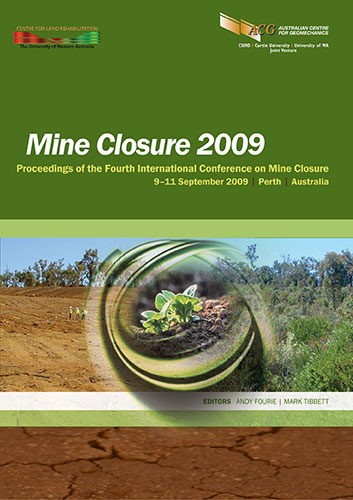Approaches to acid and metalliferous drainage management — implications of short-term trials for long-term remediation

|
Authors: Stimpfl, M; Carrigan, ML; McLeary, MB; Taylor, JR |
DOI https://doi.org/10.36487/ACG_repo/908_20
Cite As:
Stimpfl, M, Carrigan, ML, McLeary, MB & Taylor, JR 2009, 'Approaches to acid and metalliferous drainage management — implications of short-term trials for long-term remediation', in AB Fourie & M Tibbett (eds), Mine Closure 2009: Proceedings of the Fourth International Conference on Mine Closure, Australian Centre for Geomechanics, Perth, pp. 273-264, https://doi.org/10.36487/ACG_repo/908_20
Abstract:
Several waste rock (WR) acid and metalliferous drainage (AMD) management options have been tested at Brukunga Mine site for their long-term ability to suppress or minimise acidity loads emanating from the WR. A 12–24 month field demonstration assessed alkaline caps (enhanced caustic magnesia, and natural limestone), and limestone blends in their long-term capacity to control acidity loads. The first 12 months of the trial suggest alkalinity producing covers may have significant potential as an effective and sustainable AMD minimisation strategy. Acidity load produced by the test pile (TP) capped with enhanced caustic magnesia was considerably decreased when compared with baseline. These results suggest alkaline covers allow inert neutralisation precipitates to coat preferential flow pathways, minimising the interface between water and acid salts. Blended limestone did not sustain long-term minimisation/suppression of acidity loads emanating from the WR, regardless of the ratio of limestone to WR or grain size. Even though limestone blended test piles showed the highest quality leachate measured throughout the trials, all test piles showed signs of impending leachate acidification during the latter half of the trial. In particular, the quality of leachate from all limestone blended test piles showed increasing acidity and sulphate concentrations, and a decreasing alkalinity and alkalinity to acidity ratio. Little residual alkalinity remained in the leachate from the limestone blended test piles after 12 months of the trial. The trend clearly shows, that in the long term, blended test piles are likely to produce leachate of quality comparable to untreated test piles. This trial illustrates the necessity for mine closure managers to be cautious in their application of short-term findings when planning for the longer term, in relation to management of contaminants such as AMD. These trial results signify that whilst testing of approaches is necessary, the longer the time frame the better the likely prediction of long-term outcomes. A hasty approach might well result in a failure of remediation, an inability to complete mine closure, and a hefty cost with little positive outcome.
References:
Bennett, J.W. (1994) Oxidation rates in waste rock dumps and the tailings dam at Brukunga, A report to Environmental
Geochemistry International Pty Ltd, Australian Nuclear Science and Technology Organisation, Lucas Heights,
New South Wales, Report (unpublished).
Blesing, N., Lackey, J. and Spry, A. (1974) Rehabilitation of an abandoned minesite, In Proceedings of the International
Symposium on Minerals and the Environment, M.J. Jones (ed), 4–7 June 1974, London, United Kingdom.
Earth Systems Pty Ltd (2008) Waste rock pile testwork to assist with developing a rehabilitation strategy for the
Brukunga Pyrite Mine site, South Australia, Earth Systems Pty Ltd, Melbourne, Victoria, Report (unpublished).
Miller, S.D., Smart, R., Andrina, J., Neale, A. and Richards, D. (2003) Evaluation of limestone covers and blends for
long-term acid rock drainage control at the Grasberg Mine, Papua Province, Indonesia, In Proceedings of the
Sixth International Conference on Acid Rock Drainage, ICARD, 12–18 July 2003, Cairns, Australia.
Primary Industries and Resources of South Australia (PIRSA) (2001) Brukunga Mine Site Rehabilitation Rock Dump
Relocation, Adelaide, South Australian Government, Report (unpublished).
Taylor, J., Guthrie, B., Murphy, N. and Waters, J. (2006) Alkalinity producing cover materials for providing sustained
improvement in water quality from waste rock piles, In Proceedings of the Seventh International Conference on
Acid Rock Drainage, ICARD, 26–30 March 2006, St. Louis, USA.
Taylor, J., Stimpfl, M., McLeary, M. and Grindley, P. (2009) Alkalinity generating cover materials for sustainably
lowering acidity loads from waster rock piles – A field demonstration, In Proceedings of the Eighth International
Conference on Acid Rock Drainage (ICARD) 22–28 June 2009, Skellefteå, Sweden.
© Copyright 2025, Australian Centre for Geomechanics (ACG), The University of Western Australia. All rights reserved.
View copyright/legal information
Please direct any queries or error reports to repository-acg@uwa.edu.au
View copyright/legal information
Please direct any queries or error reports to repository-acg@uwa.edu.au